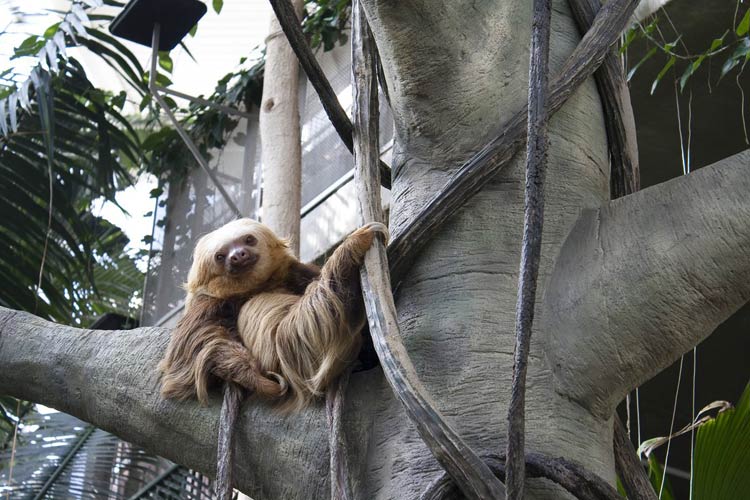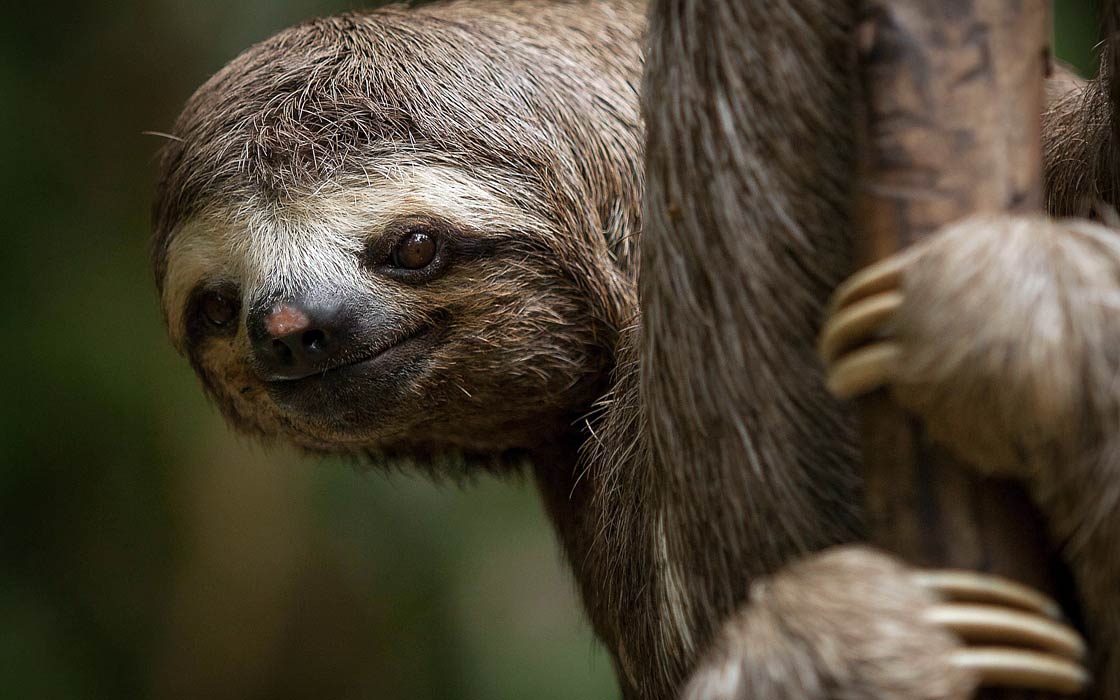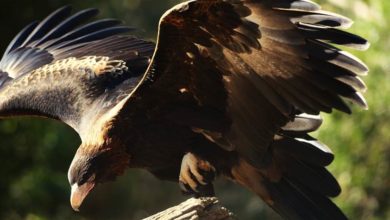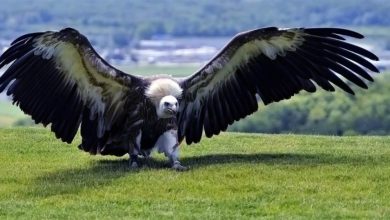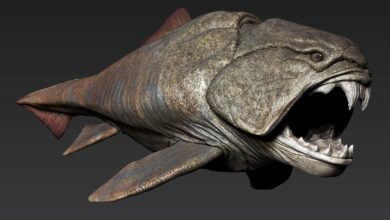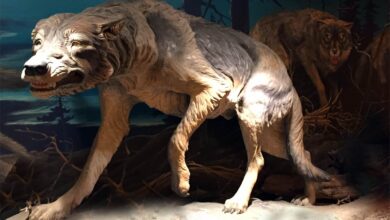The Secrets of Sloths
Beyond Slow-Motion
In the lush depths of rainforests, where time seems to slow down and the symphony of nature whispers, a creature exists that embodies tranquility and patience. With their captivating slow-motion movements and enchanting smiles, sloths have effortlessly captured the fascination of biologists, nature enthusiasts, and animal lovers alike. These remarkable mammals, whose existence can be traced back millions of years, possess a unique set of adaptations that allow them to conquer the challenges of their environment while teaching us invaluable lessons about the art of slowing down in our fast-paced world.
The Majesty of Slowness
Step into the world of sloths, and you’ll discover a realm where the concept of speed is replaced by a mesmerizing dance of unhurried grace. These enchanting creatures, whose name is derived from the Sinhalese word for “slow,” seem to float through life with a captivating tranquility that beckons us to unravel the secrets of their existence.
The Quest for Energy Efficiency
As guardians of energy efficiency, sloths have evolved a way of life that defies conventional notions of productivity. Their unhurried pace is not a sign of laziness but an ingenious strategy to adapt to their unique environment. With a diet primarily consisting of leaves, which provide limited nutrition, sloths must carefully conserve their energy to thrive in the dense rainforest canopy. Their sluggish movements and low metabolic rates enable them to survive on a meager diet and endure the scarcity of resources that challenges their survival.
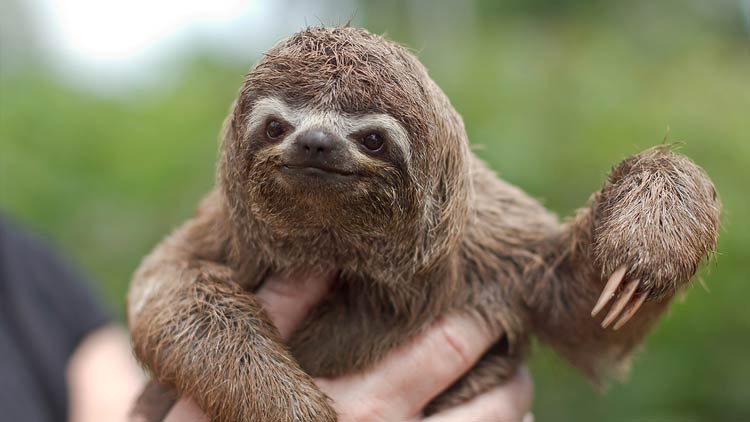
Nature’s Zen Masters
Beyond their extraordinary adaptations, sloths possess a serenity that embodies the essence of Zen philosophy. Their seemingly permanent smiles and placid expressions have earned them the reputation of being the embodiment of tranquility. Observing sloths as they hang suspended from branches or gently sway from tree to tree, one cannot help but wonder if they hold the key to finding inner peace amidst the chaos of the modern world.
The Secrets of Survival
While sloths may appear to be vulnerable due to their slow-paced lifestyle, they have evolved remarkable strategies to navigate the challenges of their environment. From their unique climbing abilities to their symbiotic relationship with algae and moss that camouflage their fur, these unassuming creatures possess a repertoire of survival mechanisms that have allowed them to flourish for millions of years.
Lessons from Sloths: Embracing Slow Living
In a world obsessed with productivity and constant motion, sloths beckon us to reevaluate our relationship with time and the importance of slowing down. These gentle beings serve as a poignant reminder that sometimes the most profound experiences and discoveries can only be unearthed by embracing stillness, observing the world around us, and savoring the simple pleasures of life.
Sloths, the masters of Zen-like existence and survival, hold the key to unlocking the art of slow living in a world that never ceases to rush. Their remarkable adaptations, enchanting nature, and gentle demeanor offer us a profound glimpse into the power of patience, reminding us to pause, appreciate the beauty of our surroundings, and find solace in the unhurried wonders of life. As we delve deeper into the secrets of these extraordinary creatures, we discover not only the marvels of nature but also valuable insights that can enrich our own human experience.

Taxonomy
- Kingdom: Animalia
- Phylum: Chordata
- Class: Mammalia
- Order: Pilosa
- Suborder: Folivora
Within the suborder Folivora, there are two families of sloths:
- Family: Megalonychidae
- Genus: Choloepus
- Species: Choloepus hoffmanni (Hoffmann’s two-toed sloth)
- Species: Choloepus didactylus (Linnaeus’s two-toed sloth)
- Genus: Choloepus
- Family: Bradypodidae
- Genus: Bradypus
- Species: Bradypus variegatus (brown-throated three-toed sloth)
- Species: Bradypus torquatus (pale-throated three-toed sloth)
- Species: Bradypus pygmaeus (pygmy three-toed sloth)
- Genus: Bradypus
These taxonomic classifications help us understand the evolutionary relationships and biological characteristics of sloths, placing them within the broader context of the animal kingdom.
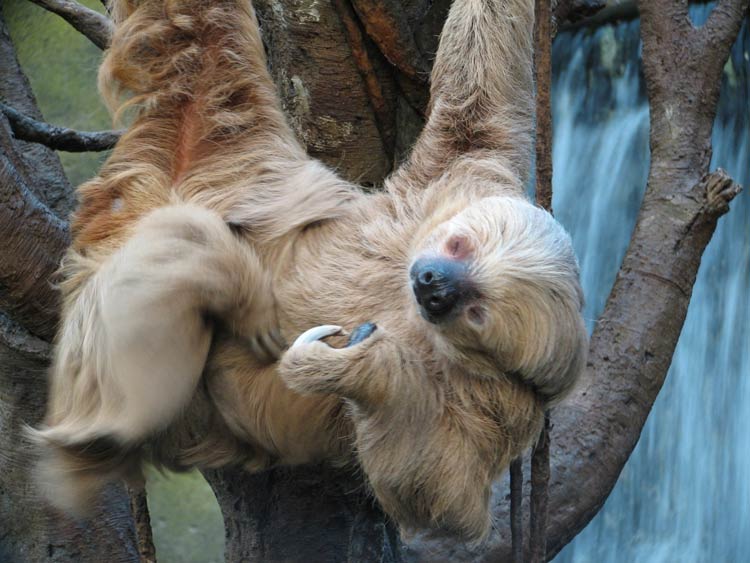
Evolution of sloths
The evolution of sloths is a fascinating journey that stretches back millions of years. These unique creatures have undergone significant adaptations to thrive in their specialized arboreal (tree-dwelling) lifestyle. Let’s delve into the evolutionary history of sloths:
- Ancient Sloths (Paleogene Period)
During the Paleogene Period, which spanned from approximately 66 to 23 million years ago, the earliest ancestors of modern-day sloths emerged. These ancient sloths belonged to the family Megatheriidae and were much larger than their present-day counterparts. They possessed diverse forms and occupied a range of habitats, including both terrestrial and arboreal environments. - Ground Sloths (Neogene Period)
In the subsequent Neogene Period, approximately 23 million to 2.5 million years ago, sloths underwent a significant diversification. One notable group that evolved during this time was the ground sloths (family Mylodontidae and Megalonychidae), which were massive, slow-moving creatures that primarily inhabited terrestrial environments. Some of these ground sloths grew to enormous sizes, such as the iconic Megatherium, which could reach heights of up to 20 feet (6 meters) when standing on its hind legs.
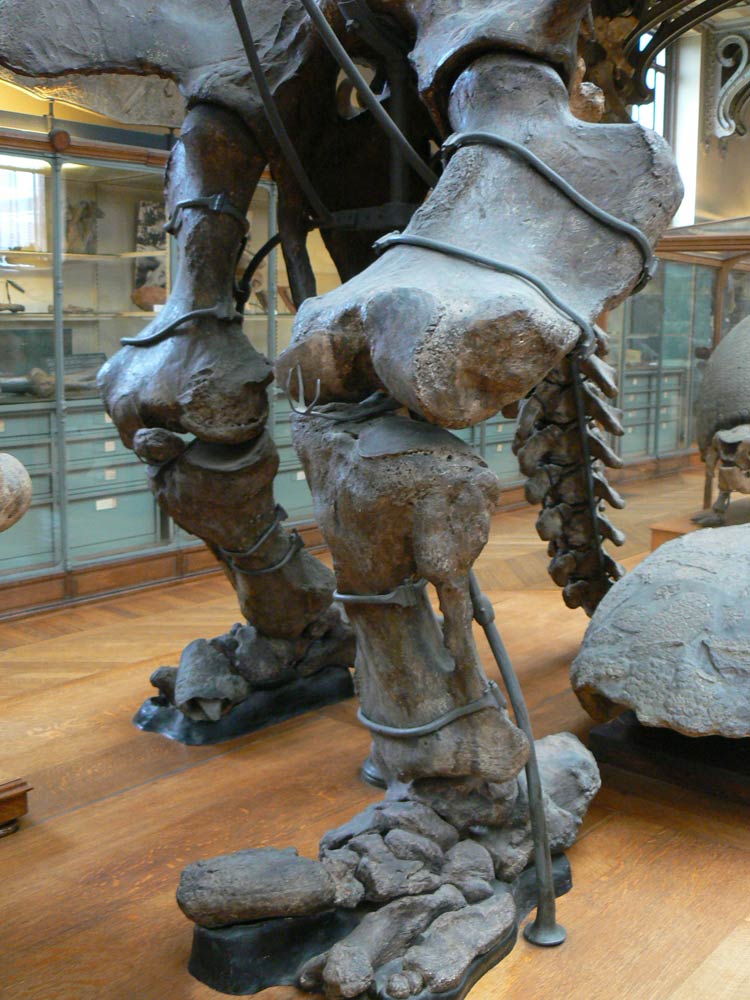
- The arrival of Arboreal Sloths (Neogene to Present)
Around 10 million years ago, a pivotal shift occurred in sloth evolution with the emergence of arboreal adaptations. Sloths gradually transitioned from a predominantly ground-dwelling lifestyle to become proficient climbers in the trees. This transition was accompanied by various anatomical changes, such as elongated limbs, specialized claws, and a reduction in body size. These adaptations allowed sloths to navigate the complex arboreal habitat more efficiently. - Two-Toed and Three-Toed Sloths
Within the arboreal sloths, two main groups exist today: two-toed sloths (family Megalonychidae) and three-toed sloths (family Bradypodidae). Despite their names, both groups actually possess three toes, but they differ in the number of digits on their front limbs. Two-toed sloths have two claws on their front limbs, while three-toed sloths have three. The two-toed sloths, represented by Hoffmann’s two-toed sloth (Choloepus hoffmanni) and Linnaeus’s two-toed sloth (Choloepus didactylus), have a more diverse diet and are generally larger in size compared to their three-toed counterparts. - Three-toed sloths, which include species such as the brown-throated three-toed sloth (Bradypus variegatus), pale-throated three-toed sloth (Bradypus torquatus), and the pygmy three-toed sloth (Bradypus pygmaeus), are specialized folivores, primarily consuming leaves. They have a slow metabolism and spend the majority of their lives suspended from tree branches, moving with a distinctive slowness.
Throughout their evolutionary history, sloths have adapted to exploit the abundant resources available in the canopy of tropical rainforests. Their unique adaptations and slow-paced lifestyle are a testament to the remarkable diversity of life on Earth and the intricate relationship between organisms and their environments.
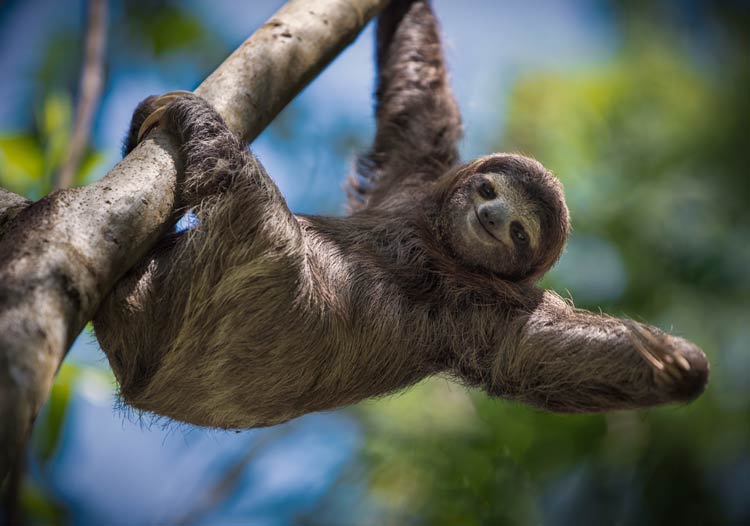
Basic facts about sloths
Size and Appearance
Sloths are medium-sized mammals, with adults typically measuring between 50 to 70 centimeters (20 to 28 inches) in length from head to tail. Depending on the species, they can weigh anywhere from 3 to 8 kilograms (6.6 to 17.6 pounds). Sloths have a stocky body, long limbs, and a short, stubby tail. Their fur is thick, coarse, and varies in color, ranging from light brown to grayish-brown.
Arboreal Lifestyle
Sloths are arboreal creatures, spending the majority of their lives in the trees. They have adapted to life in the forest canopy and are well-suited for climbing and hanging from branches. Their long, curved claws (two-toed or three-toed, depending on the species) enable them to grip onto tree branches securely.
Slow Movements
Sloths are renowned for their extremely slow movements, which are a result of their low metabolic rates. They have the slowest metabolic rate of any mammal, which allows them to conserve energy and survive on a diet that provides relatively little nutrition. On average, sloths move at a pace of about 2 meters (6.5 feet) per minute.
Diet
Sloths are folivores, primarily feeding on leaves. They have a specialized digestive system with multiple compartments that help them break down the tough cellulose present in leaves. Although their diet mainly consists of leaves, some species may also consume fruits and flowers opportunistically.
Nocturnal or Crepuscular
Sloths are predominantly nocturnal or crepuscular, meaning they are most active during the night or twilight hours. This behavior helps them avoid potential predators and conserves energy since leaves are more digestible during the cooler nighttime temperatures.
Slow Metabolism
Sloths have a slow metabolic rate, which results in low body temperature and reduced energy expenditure. This slow metabolism allows them to survive on a diet that provides limited calories and endure long periods of rest and inactivity.
Symbiotic Relationships
Sloths have a unique relationship with algae and moss. Due to their slow movements and arboreal lifestyle, their fur provides an ideal habitat for these organisms to grow. The greenish tinge of their fur acts as camouflage, blending them into their surroundings.
Conservation Status
Sloths face various threats to their survival, including habitat loss, deforestation, and illegal wildlife trade. Several sloth species are currently classified as vulnerable or endangered by conservation organizations. Efforts are being made to protect their habitats and raise awareness about the importance of conserving these remarkable creatures.
Sloths are captivating creatures with their slow-paced lifestyle, specialized adaptations, and unique ecology. Understanding their basic characteristics helps shed light on their remarkable survival strategies and emphasizes the need for their conservation in the face of ongoing environmental challenges.
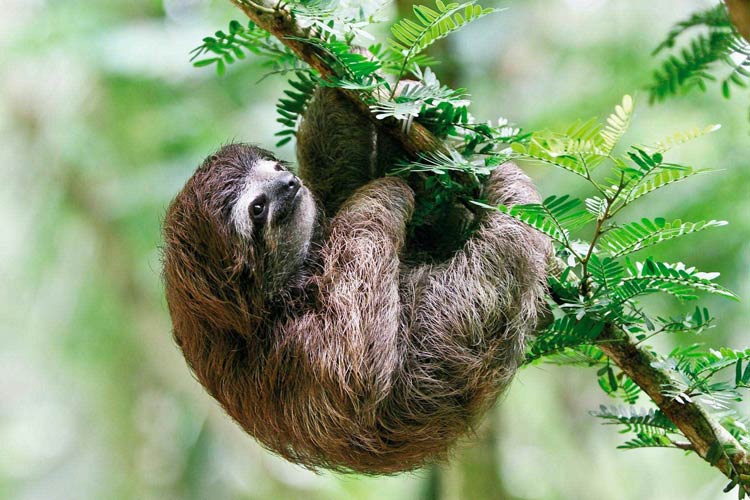
Distribution and habitat
Sloths are native to the tropical rainforests of Central and South America. They have a relatively wide distribution across various countries in the region. Here are some details about the distribution and habitat of sloths:
- Central America
Sloths can be found in several countries of Central America, including Panama, Costa Rica, Nicaragua, Honduras, and parts of Guatemala and Belize. They inhabit both lowland rainforests and montane cloud forests in this region. - South America
Sloths have a broader distribution in South America. They can be found in countries such as Venezuela, Colombia, Ecuador, Peru, Brazil, Bolivia, and parts of Argentina and Paraguay. They inhabit the Amazon rainforest, the Andean cloud forests, the Atlantic Forest, and various other forested regions in South America. - Habitat
Sloths are arboreal creatures, meaning they spend most of their lives in the trees. They are highly adapted to living in the dense canopy of tropical rainforests. Sloths prefer primary forests with tall, mature trees that provide them with abundant food sources and suitable resting places. - Canopy Dwellers
Within the rainforest, sloths are primarily found in the upper canopy layers, where they move and forage. Their slow movements and specialized adaptations, such as long claws and strong limbs, allow them to navigate the branches with ease. They rarely descend to the forest floor and are much more comfortable in the heights of the trees. - Preferred Tree Species
Sloths show a preference for certain tree species that provide them with a diet of leaves they can digest efficiently. For example, the two-toed sloths are known to favor Cecropia trees, while three-toed sloths may feed on a variety of tree species, including Cecropia, Guarumo, and the leaves of cacao and avocado trees. - Microhabitats
Within the forest canopy, sloths may occupy specific microhabitats, such as tree hollows, vine tangles, and dense foliage. These microhabitats provide them with shelter, protection, and camouflage from predators.
It’s important to note that the specific distribution and habitat preferences of sloth species may vary. Some species may have more restricted ranges or inhabit specific types of forests within their broader distribution. The preservation of their tropical rainforest habitats is crucial for the long-term survival of sloths, as these ecosystems provide the necessary resources and conditions for their unique way of life.
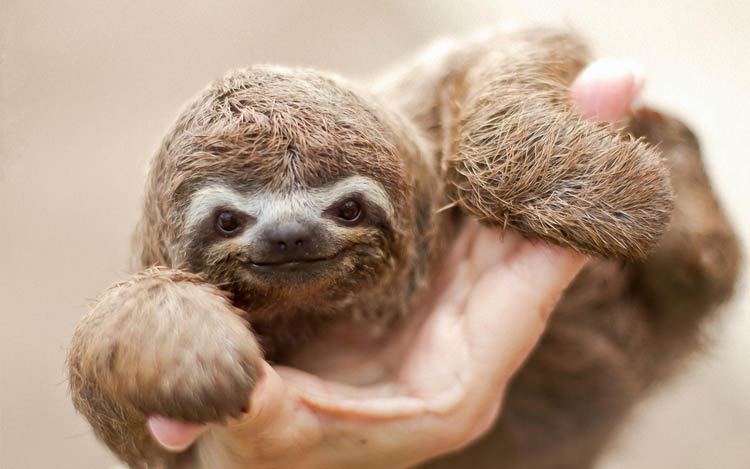
Characteristics
In the enchanting world of tropical rainforests, a creature emerges that captivates with its unique and endearing characteristics – the sloth. Let’s explore the intriguing features of sloths, from their appearance to their coat and coloration:
- Appearance
Sloths possess a distinctive and charming appearance that sets them apart from other mammals. With their stocky bodies and long, slender limbs, they exhibit a unique silhouette that speaks to their arboreal lifestyle. Their relatively small heads are adorned with a friendly and perpetually content expression, showcasing a permanent smile that melts hearts. - Size
In the realm of sloths, we encounter a delightful array of sizes. Ranging from approximately 50 to 70 centimeters (20 to 28 inches) in length, sloths fall into the category of medium-sized mammals. Although they may not be imposing in stature, their presence in the forest canopy is undeniably captivating. - Coat
Sloths boast a dense and luxurious coat that provides insulation and protection from the elements. Their fur is composed of two layers: a coarse outer layer and a softer under layer. This unique combination ensures the sloth’s comfort, allowing it to thrive amidst the varying temperatures and humidity of its rainforest habitat. - Coloration
The coloration of sloths’ coats showcases a natural palette that harmonizes with the vibrant hues of the rainforest. They commonly exhibit shades of light brown to grayish-brown, with some individuals displaying variations in color intensity. This earthy coloration grants sloths excellent camouflage, blending seamlessly with the foliage of their arboreal home. - Algae and Moss
A striking and delightful aspect of sloths’ appearance is the symbiotic relationship they share with algae and moss. The slow movements and extended periods of stillness that define sloth behavior create an ideal environment for these tiny organisms to thrive. As a result, sloths often display a subtle greenish tinge, enhancing their camouflage and providing a unique visual aesthetic.
These charming characteristics come together to form the irresistible allure of sloths. Their distinctive appearance, modest size, luxuriant coats, and natural coloration make them a true testament to the beauty and intricacy of nature’s designs. Observing a sloth amidst the verdant backdrop of the rainforest is akin to witnessing a living work of art, reminding us of the remarkable diversity and wonder that exists within our natural world.

Behavior, lifestyle and ecology
The behavior, lifestyle, and ecology of sloths offer a captivating glimpse into the unique adaptations and strategies that allow them to thrive in their arboreal habitat. Let’s delve into the fascinating world of sloth behavior:
- Slow-Moving Lifestyle
Sloths are renowned for their leisurely pace of life. They move slowly, taking deliberate and measured steps, conserving energy in the process. Their unhurried movements are a result of their slow metabolism, which allows them to survive on a low-calorie diet of leaves. - Arboreal Dwellers
Sloths are true masters of the treetops, spending the majority of their lives in the canopy of tropical rainforests. They are skillful climbers and possess adaptations such as long, curved claws and strong limbs that enable them to navigate the intricate network of branches with ease. Their natural habitat provides them with safety, resources, and an abundance of food. - Nocturnal or Crepuscular
While sloth activity patterns can vary among species, many are primarily nocturnal or crepuscular. This means they are most active during the night or twilight hours, allowing them to avoid the heat of the day and potential predators. Their slow movements and silent demeanor help them remain inconspicuous in the dark, ensuring their survival in the forest’s shadows. - Folivorous Diet
Sloths are specialized folivores, with leaves constituting the majority of their diet. They have a unique digestive system designed to extract nutrients from the fibrous leaves they consume. Though low in nutritional value, the leaves provide a consistent food source within their forest home. Some sloths may occasionally supplement their diet with fruits, flowers, and even the occasional insect. - Rest and Sleep
Sloths have a sedentary lifestyle, spending up to 15 to 20 hours each day resting or sleeping. They are often observed suspended upside down from tree branches, using their strong limbs and specialized gripping adaptations to maintain their position. This inverted resting posture serves multiple purposes, including conserving energy and providing protection from predators. - Mutualistic Relationships
The fur of sloths serves as a microhabitat for a variety of organisms, including algae and moss. This symbiotic relationship benefits both the sloth and the organisms that inhabit its fur. The greenish hue of the fur provides camouflage, effectively blending the sloth into the canopy foliage, while the algae and moss benefit from the nutrients and shelter provided by the sloth’s fur. - Adaptations for Conservation
Sloths have evolved a suite of adaptations that help them survive in their challenging rainforest environment. Their slow movements, camouflage, and cryptic behavior minimize the chances of detection by predators, while their low metabolic rate allows them to conserve energy. These adaptations contribute to their remarkable longevity in the wild.
The behavior, lifestyle, and ecology of sloths paint a portrait of a specialized and fascinating group of creatures. Their unhurried approach to life, remarkable climbing abilities, unique diet, and intricate ecological relationships make them a testament to the diverse strategies that have evolved in nature. Observing the peaceful existence of sloths in their arboreal haven serves as a reminder of the intricate web of life that exists within the lush embrace of the tropical rainforest.

Diet
Sloths have a specialized and unique diet that sets them apart from many other mammals. Their primary source of sustenance is leaves, making them specialized folivores. Let’s explore the diet of sloths in more detail:
- Leaf Consumption
Leaves form the bulk of a sloth’s diet. They feed on a variety of leaves from the trees in their habitat. However, not all leaves are suitable for sloths to consume. They have evolved to select specific types of leaves that provide them with the necessary nutrients while minimizing the intake of toxins and indigestible compounds found in certain plants. - Digestive Adaptations
Sloths possess a specialized digestive system that enables them to extract nutrients from the fibrous leaves they consume. Their digestive tract is long and complex, consisting of multiple compartments. Bacteria in their foregut help ferment and break down the tough cellulose in the leaves, making it more digestible. This fermentation process allows sloths to extract energy and nutrients from their leafy diet. - Slow Digestion
Due to the low nutritional content of leaves, sloths have a slow digestion process. It can take several days for a meal to pass through their digestive system. This slow digestive rate is another adaptation that helps sloths conserve energy, as their metabolic rate is also quite slow. - Limited Energy Intake
The leaves consumed by sloths provide relatively low amounts of energy. As a result, sloths have low metabolic rates and conserve energy by moving slowly and resting for extended periods. This lifestyle allows them to survive on a diet that may not provide substantial caloric intake. - Supplemental Foods
While leaves make up the majority of their diet, sloths may also consume other food items opportunistically. This can include fruits, flowers, and occasionally small amounts of insects. These additional food sources may provide some variation and supplement their nutritional needs. - Water Intake
Sloths derive most of their water requirements from the leaves they consume. Leaves contain moisture, which contributes to their hydration. Sloths rarely descend from the trees, and their infrequent trips to the ground mean that they have limited access to other water sources.
Sloths’ specialized folivorous diet and digestive adaptations enable them to thrive in their arboreal habitat. Their ability to extract nutrients from leaves and their slow metabolic rate allow them to survive on a diet that many other animals would find inadequate. Understanding their unique dietary requirements contributes to our appreciation of the remarkable adaptations that have evolved in these captivating creatures.
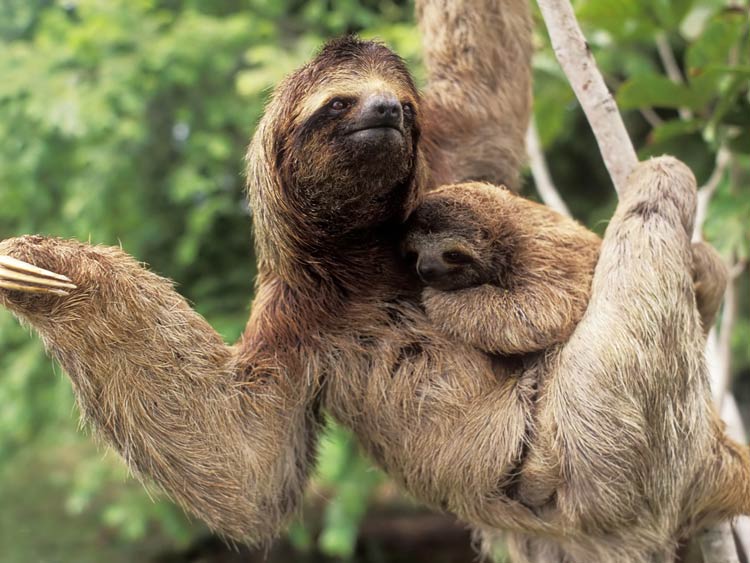
Reproduction and parenting
Reproduction and parenting in sloths reveal intriguing aspects of their life cycle and social dynamics. Let’s explore these fascinating aspects:
- Mating Behavior
Sloths exhibit relatively solitary lifestyles, and their mating behavior reflects this. During the mating season, males may engage in vocalizations and physical interactions to attract females and establish dominance. However, encounters between males and females are typically brief, as sloths are not highly social animals. - Mating System
Sloths generally have a promiscuous mating system, with multiple males mating with multiple females. Female sloths are receptive to mating for a short period, typically lasting only a few hours or days per year, during which they emit scent signals to attract potential mates. - Slow Reproductive Rate
Sloths have one of the slowest reproductive rates among mammals. Female sloths usually give birth to only one offspring at a time, and the gestation period can last anywhere from 9 to 12 months, depending on the species. This extended period contributes to the slow population growth of sloth populations. - Infant Development and Dependence
Sloth infants, called “slothlets,” are born fully furred and with their eyes open. They cling to their mother’s belly for the first few weeks of their lives and later transition to clinging to her back. The mother provides constant care and protection for her young, nursing them and grooming them regularly. - Slow Growth and Independence
Slothlets grow slowly, and their development is gradual. They remain dependent on their mothers for an extended period, usually around 5 to 12 months, before they start venturing on their own. During this time, the mother teaches her offspring essential skills for survival, such as climbing and foraging. - Dispersal and Solitary Life
Once slothlets reach a certain age and gain some independence, they disperse from their mother’s territory to establish their own home ranges. Sloths are primarily solitary animals, with minimal social interaction between individuals outside of mating encounters. Each sloth occupies its own defined area in the forest canopy, reducing competition for resources. - Lifespan
Sloths have relatively long lifespans compared to other mammals of similar size. In the wild, sloths can live up to 20 years or more, depending on the species and environmental factors. The slow pace of their lifestyle, low metabolic rate, and lack of natural predators contribute to their longevity.
The reproductive and parenting behaviors of sloths highlight their unique adaptations to the challenges of their arboreal lifestyle. The slow reproductive rate, an extended period of maternal care, and gradual development of offspring ensure the survival and success of the species in their specialized rainforest habitats. Observing the delicate dynamics of sloth reproduction and parenting provides us with a deeper understanding of the intricacies of their natural world.

Predators and Threats
While sloths may seem well-suited for a life of tranquility in the treetops, they are not without their share of predators and threats. Let’s explore some of the challenges sloths face in their natural environment:
- Predators
Despite their elusive nature and excellent camouflage, sloths have a few natural predators. Among them are large birds of prey, such as harpy eagles and crested eagles, which can swoop down from above to snatch unsuspecting sloths from the trees. Additionally, jaguars and large snakes, like anacondas and boa constrictors, pose a threat to sloths, especially when they venture down to the forest floor. - Deforestation
One of the greatest threats to sloth populations is deforestation. As vast areas of tropical rainforests are cleared for agriculture, logging, and urbanization, sloths lose their natural habitat. The destruction of their forest homes fragments their populations, isolating individuals and hindering their ability to find sufficient food and mates. - Habitat Loss and Fragmentation
Habitat loss not only disrupts the natural balance of sloth populations but also leads to habitat fragmentation. When large forested areas are divided into smaller patches, sloths face difficulties in finding suitable feeding grounds and establishing their territories. Fragmentation also exposes them to greater risks from predators and reduces genetic diversity within populations. - Road Mortality
Roadways that cut through sloth habitats present another significant threat. Sloths are slow-moving creatures, making them vulnerable to collisions with vehicles. This threat, combined with their low reproductive rates, can have severe impacts on local sloth populations, particularly in areas where roads intersect their natural habitat. - Illegal Wildlife Trade
Sloths, especially baby sloths, are sometimes targeted for the illegal pet trade. Capturing and trafficking sloths for the exotic pet market can result in the separation of young sloths from their mothers, leading to high mortality rates. Additionally, the stress and unnatural living conditions of captivity pose significant welfare concerns for these wild animals. - Climate Change
Climate change brings a range of challenges for sloths. Alterations in temperature and precipitation patterns can affect the availability of food resources and disrupt the delicate balance of their rainforest habitats. Changes in climate can also impact the distribution and abundance of their natural predators and prey, further influencing the dynamics of sloth populations.
Efforts to protect sloths and mitigate these threats involve initiatives such as establishing protected areas, promoting sustainable land use practices, combating illegal wildlife trade, and raising awareness about the importance of conserving their unique habitats. By addressing these challenges, we can strive to ensure the continued survival and well-being of these remarkable creatures that grace the canopy of the tropical rainforests.

Interactions with humans
Interactions between sloths and humans can be both positive and negative. Here are some of the ways in which humans and sloths interact:
- Tourism and Education
Sloths have become popular attractions for ecotourism, drawing visitors who are fascinated by their unique appearance and slow-paced lifestyle. Tourists have the opportunity to observe sloths in their natural habitat, raising awareness about their conservation needs. Educational programs and guided tours also help promote understanding and appreciation for these captivating creatures. - Conservation Efforts
Humans play a crucial role in the conservation of sloths. Organizations and individuals work tirelessly to protect sloth habitats, establish rescue and rehabilitation centers for injured or orphaned sloths, and conduct scientific research to better understand their behavior and conservation requirements. Conservation efforts are vital for ensuring the long-term survival of sloth populations. - Habitat Destruction and Fragmentation
Human activities, such as deforestation for agriculture and urban development, directly impact sloth habitats. As their natural forest homes are destroyed or fragmented, sloths face challenges in finding suitable food sources, establishing territories, and moving between forest patches. Efforts to promote sustainable land use and protect critical habitats are crucial to mitigate these negative impacts. - Wildlife Trafficking and Illegal Pet Trade
Sloths are sometimes illegally captured and traded as pets. This practice is not only detrimental to individual sloths but also has negative consequences for wild populations. The illegal pet trade disrupts natural behaviors, separates young sloths from their mothers, and can lead to high mortality rates. Strict enforcement of laws and public awareness campaigns are essential in combating this issue. - Road Accidents
Sloths’ slow movements and arboreal lifestyle make them vulnerable to road accidents when they cross or descend to the forest floor. Human infrastructure, such as roads and highways, can fragment sloth habitats and increase the risk of collisions with vehicles. Efforts to implement wildlife corridors, signage, and speed restrictions in sloth habitats can help reduce these accidents. - Human-Wildlife Conflict
Occasionally, sloths may come into conflict with humans when their natural habitat overlaps with human settlements. Sloths may wander into urban areas in search of suitable trees or encounter challenges in crossing roads. It is important to promote coexistence and implement measures to ensure the safety of both humans and sloths in these situations.
Understanding and respecting the needs of sloths is crucial for fostering positive interactions and minimizing negative impacts. By promoting conservation efforts, responsible tourism practices, and raising awareness about the importance of protecting their habitats, we can strive for harmonious coexistence with these fascinating creatures.

Population
Estimating the precise population size of sloths is challenging due to their elusive nature and the vastness of their rainforest habitats. However, population assessments have been conducted for specific species and regions. Here are some general insights into sloth populations:
- Variable Population Density
Sloth population density can vary significantly depending on the species and the quality of their habitat. In some areas, sloths can have relatively high densities, especially in regions with abundant food resources and suitable forest cover. However, overall, sloth populations tend to have lower densities compared to many other mammals. - Threatened Status
Certain sloth species are classified as threatened or endangered. For example, the pygmy three-toed sloth (Bradypus pygmaeus) and the Maned sloth (Bradypus torquatus) are listed as critically endangered by the International Union for Conservation of Nature (IUCN). These species face significant population declines due to habitat loss, fragmentation, and other threats. - Population Declines
Sloth populations have been negatively impacted by human activities, particularly deforestation and habitat destruction. As large areas of tropical rainforests are cleared for agriculture, logging, and urbanization, sloths lose their essential habitat and face population declines. Additionally, other factors such as illegal wildlife trade and road mortality further threaten their populations. - Conservation Efforts
Conservation organizations and researchers are actively working to protect and conserve sloth populations. Efforts include establishing protected areas, implementing sustainable land use practices, conducting scientific research, rescuing and rehabilitating injured or orphaned sloths, and raising awareness about the importance of sloth conservation. - Localized Population Studies
Some specific regions and habitats have been the focus of population studies. For instance, the Sloth Sanctuary of Costa Rica has been conducting research on sloth populations in their area, providing valuable insights into population dynamics, behavior, and conservation strategies.
Given the challenges in accurately estimating sloth populations across their entire range, ongoing research and monitoring efforts are crucial for obtaining a comprehensive understanding of their numbers and conservation status. Protecting their habitats, implementing sustainable practices, and addressing the key threats they face are essential for ensuring the long-term survival and well-being of sloth populations.
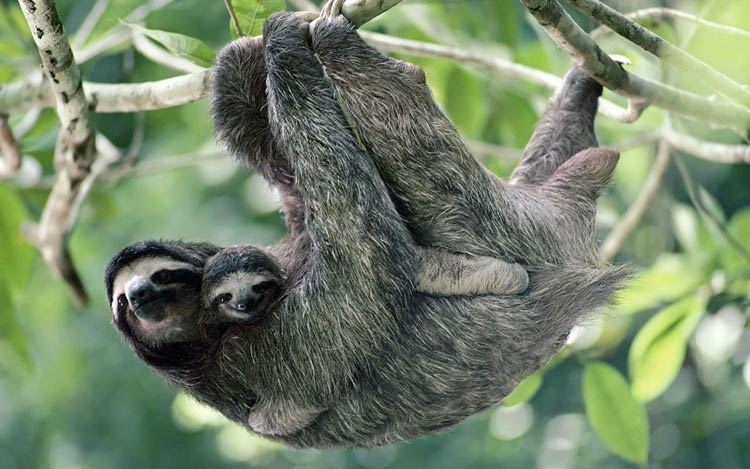
Status and conservation
Sloths face various conservation challenges, primarily due to habitat loss, fragmentation, and human-induced threats. Here is an overview of their conservation status and ongoing efforts to protect these unique creatures:
- IUCN Red List Status
Several sloth species are listed on the International Union for Conservation of Nature (IUCN) Red List of Threatened Species. For example, the pygmy three-toed sloth (Bradypus pygmaeus) is listed as critically endangered, while other species such as the Maned sloth (Bradypus torquatus) and the Hoffmann’s two-toed sloth (Choloepus hoffmanni) are classified as vulnerable. These designations indicate the urgent need for conservation actions to prevent further population declines. - Habitat Loss and Fragmentation
Deforestation for agriculture, logging, and urbanization poses a significant threat to sloth populations. As their forest habitats are destroyed or fragmented, sloths lose essential food sources, nesting sites, and safe corridors for movement. Protecting and restoring their natural habitats is crucial for their long-term survival. - Conservation Initiatives
Numerous conservation organizations and initiatives focus on sloth conservation. They work to raise awareness about the importance of sloths and their habitats, conduct research on their biology and behavior, establish protected areas, and implement sustainable land use practices. These efforts aim to mitigate threats, promote coexistence, and ensure the preservation of sloth populations. - Sustainable Land Use
Encouraging sustainable land use practices, such as agroforestry and reforestation, can help mitigate habitat loss and fragmentation. By promoting the integration of trees and agriculture, sloth habitats can be preserved or restored while providing livelihoods for local communities. - Wildlife Rehabilitation and Rescue
Many organizations operate sloth rescue and rehabilitation centers, providing care for injured, orphaned, or illegally traded sloths. These facilities aim to rehabilitate sloths for release back into the wild whenever possible, contributing to the conservation of sloth populations. - Community Engagement
Involving local communities in sloth conservation efforts is crucial for sustainable and effective conservation. By providing education, livelihood opportunities, and promoting the value of preserving sloth habitats, local communities become stakeholders in their protection. - Research and Monitoring
Ongoing research and monitoring of sloth populations are essential for understanding their biology, behavior, and population trends. These efforts provide valuable data for conservation planning, identifying priority areas for protection, and evaluating the effectiveness of conservation measures.
Preserving sloth populations requires a comprehensive approach that addresses the complex interplay of habitat preservation, sustainable practices, community engagement, and legal protection. By combining scientific research, conservation initiatives, and public awareness, we can strive to safeguard these captivating creatures and their invaluable rainforest ecosystems for future generations.
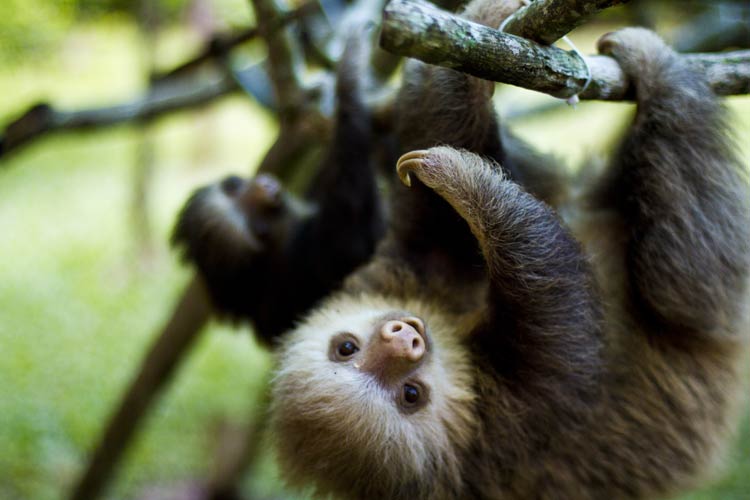
Comparison of Two-toed sloths and Three-toed sloths
Two-toed sloths and three-toed sloths are both members of the sloth family, but they have distinct differences in their characteristics and behavior. Here’s a comparison between the two:
Physical Differences
- Limbs
Two-toed sloths have two fingers on their front limbs, while three-toed sloths have three fingers. This difference is based on the number of bony elements in their forelimbs. - Size
Two-toed sloths are generally larger than three-toed sloths. Two-toed sloths can reach lengths of 55 to 75 centimeters (22 to 30 inches) and weigh up to 8 to 10 kilograms (18 to 22 pounds), while three-toed sloths are smaller, averaging lengths of 45 to 60 centimeters (18 to 24 inches) and weights of 3 to 6 kilograms (7 to 13 pounds).
Behavioral Differences
- Activity Levels
Two-toed sloths tend to be more active and mobile compared to their three-toed counterparts. Two-toed sloths are known to cover more ground, while three-toed sloths have a more sedentary lifestyle, spending the majority of their time hanging upside down from tree branches. - Metabolic Rates
Two-toed sloths have a slightly higher metabolic rate compared to three-toed sloths. This metabolic difference contributes to the variation in their activity levels and energy requirements.
Habitat Differences
- Geographic Distribution
Two-toed sloths are found in Central and South America, primarily in the Amazon rainforest and surrounding regions. Three-toed sloths have a wider distribution and can be found in Central and South America, including parts of the Amazon, as well as in Central America and the Caribbean islands. - Habitat Preferences
Two-toed sloths are more adaptable in terms of habitat preference. They can be found in both lowland rainforests and deciduous forests. Three-toed sloths, on the other hand, are primarily associated with tropical rainforests.
Feeding Differences
- Diet: Both two-toed and three-toed sloths are herbivores, but they have some differences in their dietary preferences. Two-toed sloths have a broader diet and consume a wider variety of leaves, fruits, and flowers. Three-toed sloths, on the other hand, have a more specialized diet and primarily feed on leaves.
While two-toed and three-toed sloths share similarities in their arboreal nature and slow movements, their differences in limb structure, size, activity levels, and dietary preferences set them apart. Understanding these distinctions helps us appreciate the diversity within the sloth family and their unique adaptations to their respective habitats.

Sloths in numbers
Sloths exhibit unique physical characteristics and behaviors that set them apart from many other animals. Here are some approximate numbers and dimensions related to sloths:
Detailed data / dimensions (size)
- Total height: 50 to 70 centimeters (20 to 28 inches) from head to tail
- Height at the withers:
- Males: 30 to 35 centimeters (12 to 14 inches)
- Females: 30 to 35 centimeters (12 to 14 inches)
- Weight:
- males: 4 to 8 kilograms (9 to 18 pounds)
- females: 3 to 6 kilograms (7 to 13 pounds)
- Lifespan:
- up to 20 years or more in the wild
- 30 years or more in captivity
- Max speed: 0.24 to 0.48 kilometers per hour (0.15 to 0.3 miles per hour) on the ground. They are much more agile and efficient when navigating through the trees.
It’s important to note that these numbers and dimensions are general estimates, and variations can occur among different sloth species and individuals. Additionally, the specific measurements may differ slightly depending on the available scientific literature and the particular species of sloth under consideration.
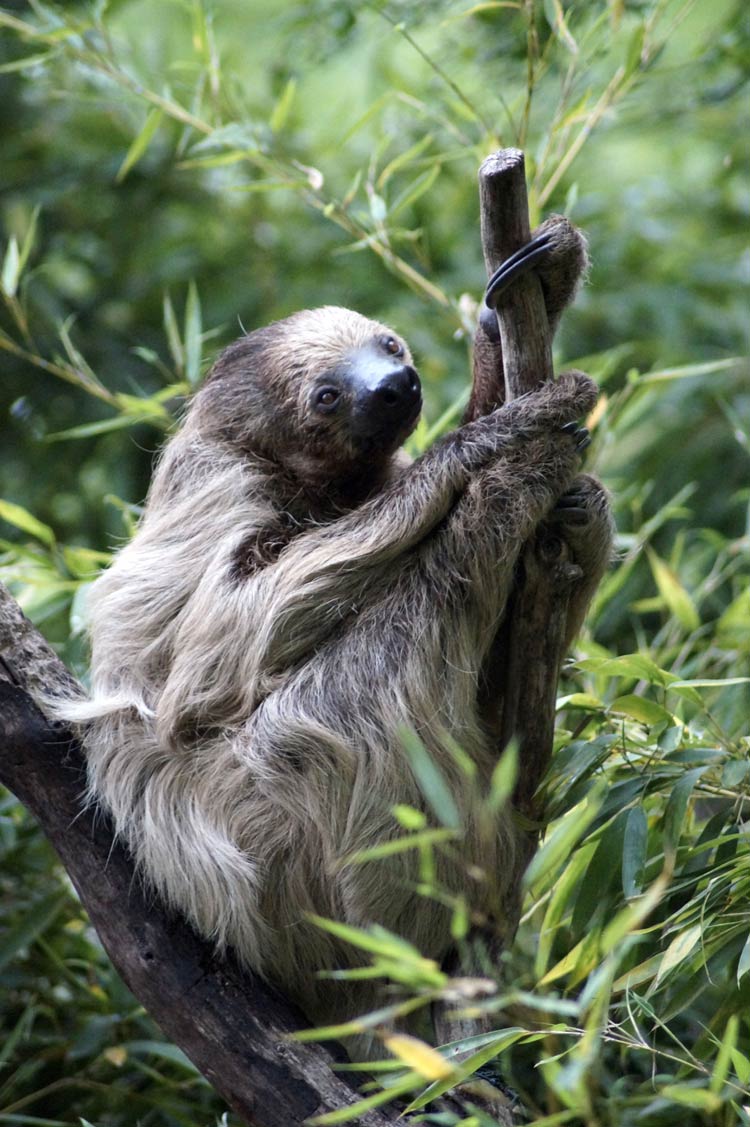
Sloths in culture
Sloths have captivated the imagination of people around the world and have found their way into various aspects of culture. Here are some examples of how sloths are represented and celebrated in different cultural contexts:
- Folklore and Indigenous Beliefs
In certain indigenous cultures of Central and South America, sloths are revered and feature in folklore and myths. They are often associated with wisdom, patience, and a deep connection to the natural world. Sloths are sometimes seen as spiritual beings or symbols of balance and tranquility. - Pop Culture
Sloths have gained popularity in contemporary pop culture, appearing in movies, cartoons, and advertisements. Animated films like “Zootopia” and “Ice Age” feature memorable sloth characters that entertain audiences with their slow and humorous personalities. Sloths are also frequently portrayed in cute and comical illustrations, merchandise, and internet memes, further solidifying their cultural presence. - Conservation Icons
Sloths have become symbols of conservation efforts, representing the need to protect vulnerable species and their habitats. Their charming and gentle nature has helped raise awareness about rainforest conservation and the importance of preserving biodiversity. Sloths often serve as ambassadors for environmental organizations, campaigns, and educational programs. - Art and Design
Sloths inspire artists and designers with their distinctive appearance and laid-back demeanor. Their unique features and slow movements make them popular subjects for paintings, sculptures, and artistic creations. Sloth motifs can be found in various forms of art, from traditional to contemporary, reflecting their cultural significance. - Symbol of Relaxation
Sloths are often associated with relaxation and taking life at a slower pace. Their unhurried lifestyle resonates with those seeking moments of calm and mindfulness in a fast-paced world. Sloth-themed merchandise, such as clothing, accessories, and home decor, often features messages promoting relaxation, self-care, and embracing a leisurely lifestyle. - Tourism and Souvenirs
In regions where sloths are found, they attract tourists eager to catch a glimpse of these fascinating creatures. Sloth-themed tours, eco-lodges, and wildlife sanctuaries offer visitors the opportunity to observe and learn about sloths in their natural habitats. Souvenirs and crafts featuring sloth motifs are popular among tourists as reminders of their encounters with these remarkable animals.
The cultural significance of sloths reflects their endearing qualities and the human fascination with their unique lifestyle. Whether through ancient beliefs, modern entertainment, or conservation symbolism, sloths have become beloved icons that inspire awe, creativity, and a connection to the natural world.
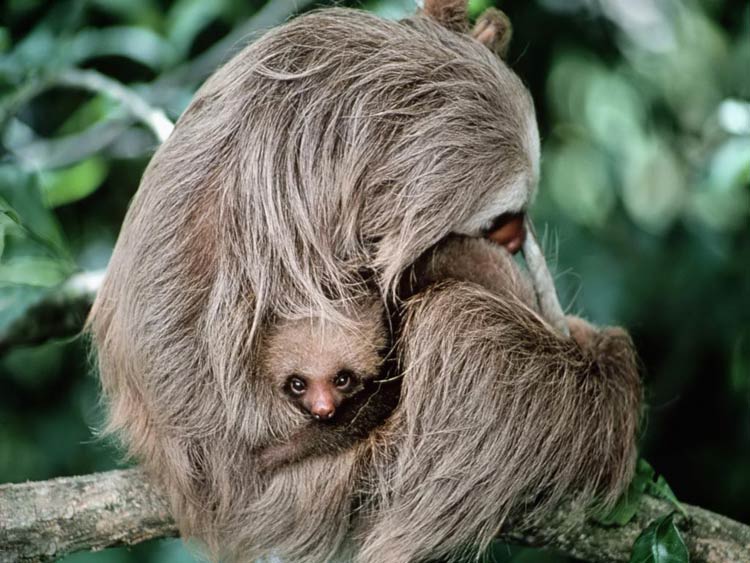
Sloths in movies
Sloths have made appearances in several movies, often adding a touch of humor and charm to the storylines. Here are a few notable examples:
- “Ice Age” series
The “Ice Age” animated film franchise features a lovable and slow-witted sloth named Sid. Sid, voiced by John Leguizamo, becomes a prominent character in the series, providing comic relief with his quirky personality and hilarious antics. - “Zootopia”
In the Disney animated film “Zootopia,” a scene-stealing character named Flash is a three-toed sloth working at the Department of Mammal Vehicles. Flash’s slow speech and deliberate movements add a delightful comedic element to the film. - “The Croods”
“The Croods” is an animated adventure-comedy film that follows a prehistoric family. In the movie, a sloth named Belt, voiced by Chris Sanders, serves as the loyal and humorous sidekick to the protagonist, Guy. Belt’s infectious enthusiasm and distinctive catchphrase “Dun Dun Dahhh!” have become fan favorites. - “The Sloth”
“The Sloth” is a short film released by Pixar Animation Studios as part of their “SparkShorts” program. The film portrays a busy city street coming to a standstill when a sloth decides to cross the road, showcasing the sloth’s slow nature in a comical and heartwarming way.
These movies have helped popularize sloths and their unique characteristics, portraying them as endearing, funny, and memorable characters. The lovable portrayal of sloths in these films has contributed to their cultural recognition and increased the fascination and appreciation for these extraordinary animals.

Interesting facts about sloths
- Slowest Mammals
Sloths are known for their incredibly slow movement. They have one of the slowest metabolic rates among mammals, with an average speed of just 0.24 to 0.48 kilometers per hour (0.15 to 0.3 miles per hour). This slow pace is primarily due to their low-energy diet and their adaptation to conserve energy in their arboreal habitats. - Hanging Upside Down
Sloths spend the majority of their lives hanging upside down from tree branches. Their unique anatomy allows them to have a strong grip and specialized tendons that lock their claws in place. Hanging upside down conserves energy, provides camouflage, and allows them to feed on leaves more easily. - Sleepy Lifestyle
Sloths are among the sleepiest creatures on Earth. They can sleep for up to 15 to 20 hours a day! Their sedentary lifestyle is a result of their slow metabolism and low-energy diet. They conserve energy by being inactive and have specialized adaptations to sleep while hanging upside down. - Plant-Based Diet
Sloths are herbivores and have a specialized diet consisting mainly of leaves. Their digestion is slow and inefficient, taking up to a month to fully process a single meal. Their long digestive system helps break down tough plant material, but their diet provides limited nutrients and energy, which contributes to their slow metabolism. - Algae on Their Fur
Sloths have a greenish tinge to their fur, which is often mistaken for moss. In reality, their fur provides a habitat for algae and other microorganisms. This unique symbiotic relationship benefits both the sloths and the algae, providing camouflage for the sloths and a source of nutrients for the algae. - Surprisingly Good Swimmers
Despite their slow movements on land, sloths are surprisingly adept swimmers. They can use their long arms to paddle through the water, and they have been observed crossing rivers and even swimming between islands in some cases. - Three-Toed vs. Two-Toed Sloths
Sloths are divided into two main groups: three-toed and two-toed sloths. Interestingly, both groups actually have three toes, but the difference lies in the number of fingers they possess. Three-toed sloths have three fingers on their front limbs, while two-toed sloths have two fingers. This distinction is based on the number of bony elements in their forelimbs.
These intriguing facts showcase the unique adaptations and behaviors of sloths, highlighting their slow-paced lifestyle, specialized diet, and their ability to thrive in their arboreal habitats. Sloths continue to captivate our curiosity and remind us of the incredible diversity found in the animal kingdom.
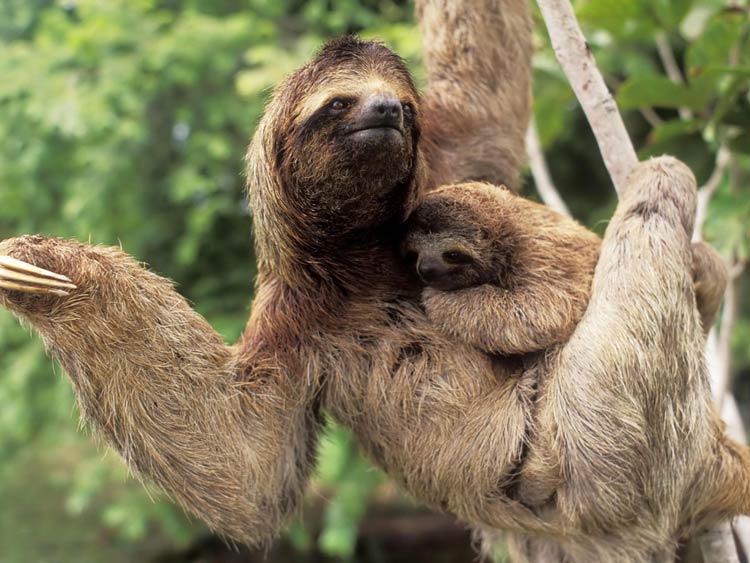
Q&A (questions and answers) about sloths
Q: What are sloths?
A: Sloths are arboreal mammals known for their slow movements, found in the tropical rainforests of Central and South America. They belong to the family Bradypodidae and are divided into two main groups: two-toed sloths and three-toed sloths.
Q: Why are sloths so slow?
A: Sloths have a slow metabolism and low-energy diet consisting mainly of leaves. Their slow movements help them conserve energy and remain hidden from predators. The slow pace also aids in their digestion process, which is slow and inefficient.
Q: What do sloths eat?
A: Sloths are herbivores and primarily feed on leaves. Their diet consists mainly of the leaves of trees such as Cecropia, hibiscus, and figs. Although they are not very efficient at digesting their food, they have specialized adaptations to extract nutrients from tough plant material.
Q: Do sloths sleep all the time?
A: Sloths have a reputation for being sleepy animals, but they do not sleep all the time. They have a slow metabolism and sleep for extended periods, ranging from 15 to 20 hours a day. However, during their waking hours, they are alert and active, feeding and moving around in the trees.
Q: How do sloths move in trees?
A: Sloths have strong limbs and long claws that allow them to hang from tree branches and move slowly. They use their powerful arms to pull themselves along branches and their claws provide a firm grip. Their slow movement helps them avoid detection by predators and conserves energy.
Q: Are sloths good swimmers?
A: Despite their slow movements on land, sloths are surprisingly good swimmers. They can use their long arms to paddle through water, and they have been observed crossing rivers and swimming between islands. Swimming allows them to move between trees and find new feeding grounds.
Q: Do sloths come down from trees?
A: Sloths spend the majority of their lives in trees and are well adapted to an arboreal lifestyle. However, they do come down from trees occasionally, usually once a week, to defecate. This behavior is risky for them as they become more vulnerable to predators on the ground.
Q: Do sloths have predators?
A: Sloths have a few natural predators, including large birds of prey such as harpy eagles and some big cat species like jaguars and ocelots. While their slow movements make them vulnerable, their coloration and camouflage help them blend into the foliage and reduce the risk of predation.
Q: Are sloths endangered?
A: Sloth populations face various threats, including habitat loss due to deforestation, illegal wildlife trade, and road accidents. While some sloth species are listed as endangered or vulnerable, the conservation status varies depending on the species and their specific habitats.
Q: Can sloths be kept as pets?
A: Sloths are wild animals and should not be kept as pets. They have specialized needs and require specific habitats and diets that are difficult to replicate in a domestic setting. It is also illegal to keep sloths as pets in many countries to protect their conservation status and welfare.
Q: How long do sloths live?
A: Sloths have relatively long lifespans compared to other mammals of similar size. In the wild, they can live up to 20 years or more, depending on the species and environmental factors. Sloths kept in captivity may have longer lifespans, with some individuals reaching 30 years or more.
